by John Copley
(ANNews) The Indian Group of Seven, formally known as Professional Native Indian Artists Incorporated (PNIAI) was founded in Winnipeg in November of 1973. The precursor to the establishment of the now world renowned group of Indigenous artists came about a year earlier when Alex Janvier, Jackson Beardy and Daphne Odjig gathered at Odjig’s house in Manitoba’s capital to host a joint exhibition of their work. That exhibition, entitled “Treaty Numbers 23, 287 and 1171” was the beginning of the end of an all-too-long era in which Aboriginal artists were shunned and their work deemed as little more than simple arts and crafts.
“It was a significant time in my life and as it turns out, a very important moment in time,” reminisced the youngest and only non-Canadian member of the Indian Group of Seven, Joseph Sanchez in a recent interview. “Daphne was and is a strong, proud and determined woman and when she invited us all (Jackson Beardy, Eddy Cobiness, Alex Janvier, Norval Morrisseau, Daphne Odjig, Carl Ray and Joseph Sanchez) to Winnipeg in the late fall of 1973 it didn’t take us long to realize that we all had the same goals; we wanted our art to be recognized and we wanted to be treated fairly. We decided to do what it took to change people’s perspectives and how we were treated by the large galleries that until then had not showcased our work in any of the major venues.
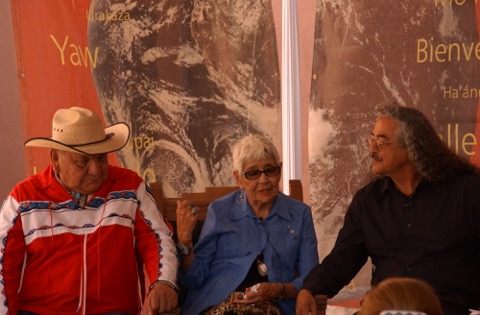
Alex Janvier and Joseph Sanchez pictured above with Daphne Odjig. Both Sanchez and Janvier will be in attendance in Edmonton at the Bearclaw Gallery on March 3 and the Art Gallery of Alberta on March 5.
“Daphne’s courage and determination were motivating factors and we were all ready to participate in every effort to see our goals become a reality. I am so very appreciative that I was invited to join this unique group of talented and well-meaning artists. They were all wonderful mentors, outstanding individuals who took me under their wing and taught me how to fly. The 1970s was an important time and one that saw Indigenous art begin to move from the basement to the upper floors as it continued to receive support from both the prominent galleries and from the Canadian public.”
From March 5-July 3 the Alberta Art Gallery will host, 7: Professional Native Indian Artists Incorporated, an exhibition of art created by the PNIAI during the 1970s. Only three members of the Group are still alive today, but all seven will come together in spirit, to reunite when more than 80 pieces of their incredible work is presented to the public next month. Edmonton is the last of six different major Canadian cities to host the exhibit since it was first presented by exhibition organizer, The MacKenzie Art Gallery in Regina, Saskatchewan in 2013.
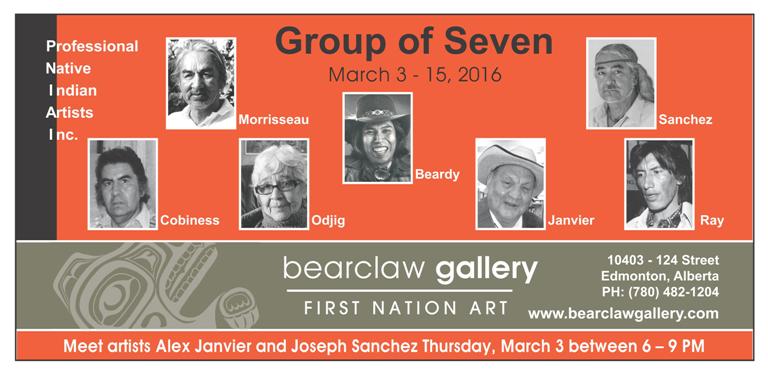 “Alex and I will both be in Edmonton a little early for this one because we are also part of an exhibition taking place at the Bearclaw Gallery on 124 Street. That exhibition runs from March 3-15 and will feature both new and collectable works from members of the group. We will be at the gallery from 6- 9 p.m on Thursday, March 3.”
“Alex and I will both be in Edmonton a little early for this one because we are also part of an exhibition taking place at the Bearclaw Gallery on 124 Street. That exhibition runs from March 3-15 and will feature both new and collectable works from members of the group. We will be at the gallery from 6- 9 p.m on Thursday, March 3.”
Janvier and Sanchez will also participate in a free lecture with MacKenzie Art Gallery curator Michelle LaVallee on March 5 at 1 p.m. at the Art Gallery of Alberta to discuss their experience in the creation of 7: Professional Native Indian Artists Inc. Seating is limited so gallery visitors should register online at youraga.ca.
The name Indian Group of Seven came about in 1974 when Winnipeg Free Press reptorter Gary Scherbain compared them with a group of seven impressionist artists who’d made their name in the 1920s painting well known Canadian landscapes.
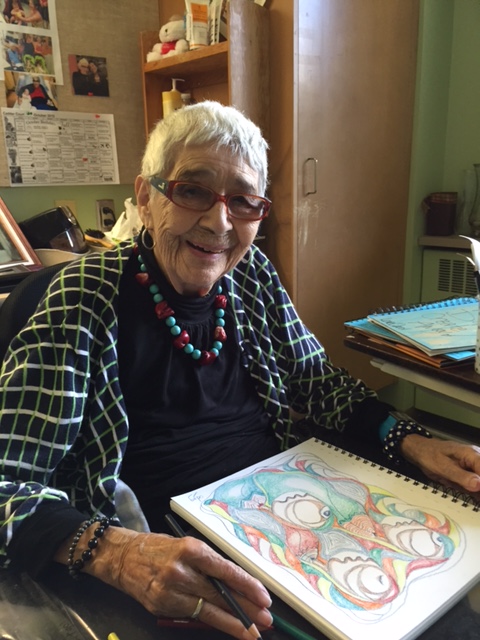
Daphne Odjig was the driving force behind the Indian Group of Seven and their quest to be taken seriously as artists.
Odjig was considered to be the driving force that brought the group together on that cold day in 1973 to discuss their work and talk about what lay ahead. The artists wanted to see major changes and were determined to see their work recognized and accepted for what it was: quality art from brilliant artists – art that told the story of an entire people and their way of life.
The seven artists put a show together in 1974 and it was a big success. The turnout and the reviews that followed helped to enable the group to realize what they wanted from the outset, recognition as professional, contemporary artists. To achieve their goals they developed several initiatives, and though their ideas, at that time, might not have seemed realistic to larger gallery administrators, they did register with the paying public. Among those goals were the development of a fund that would enable artists to afford materials to paint with; trips to Aboriginal communities to inspire young and emerging artists; the development of marketing strategies to encourage Canada’s more prestigious galleries to showcase their work and the establishment of a trust fund that could be utilized for scholarships to help emerging artists.
The March 5 – July 3 exhibition at the Alberta Art Gallery focuses on the collective impact of the group members as well as the distinctive style of each individual artist.
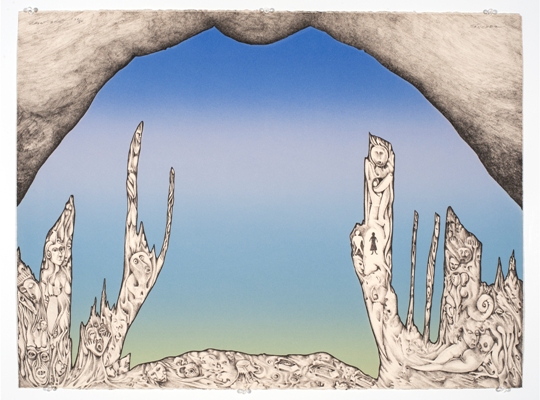
Ghost Shirt (1979-80 stone lithograph) by Joseph Sanchez will be on exhibit at the Art Gallery of Alberta in Edmonton from March 5 – July 3 as part of the highly acclaimed 7: Professional Native Indian Artists exhibit. Photo credit: Don Hall
Joseph Sanchez was born in Trinidad, Colorado in February of 1948. He spent his formative years on the White Mountain Apache Indian Reservation, graduating from Alchesay High School in Whiteriver, Arizona where his family continues to reside today.
“I became interested in art and painting in 1956 when my Grade 5 teacher, Ms. Guiterrez encouraged me to do so,” explained the 67 year old artist. “My initial attempts were quickly followed up by fantasy nudes of my female classmates that were confiscated constantly by my teachers.”
Those early sketches of classmates in the nude weren’t created in disrespect or with any sexual fantasies in mind; it was simply the artist’s way of expressionism.
“Even today I get a lot of questions about the work I do that focuses on or includes various parts of the human anatomy,” he chuckled. “These drawings and paintings, however, are not meant to be hurtful, degrading, sexist or anything other than what they are: stories and legends in their truest form.”
Sanchez’s “surrealist style” began to emerge in 1968 when he was a member of the United States Marine Corp.
“It was a drawing on newsprint entitled, Unconsummated Rape of Mongo, a first look into my psyche. I completed a newer version in 1970 and I showed it to Daphne Odjig in Winnipeg during the fall of 1971. She purchased the work and created an offset print and that in turn launched a career that continues today.”
Joseph Sanchez is the only non-Canadian member of the Group of Seven, just as Daphne Odjig is the only woman.
“Those things didn’t matter to us then, nor do they today,” he assured. “We were and are Indigenous artists and if it wasn’t for Daphne I would not be talking to you about art today; she is the reason I am an artist. She was a great mentor who encouraged my talent and coached me as an artist and art professional. We remain very good friends today; I saw her recently and at 96 years of age she remains feisty and proud; she is still doing her thing – drawing and painting and loving life.”
His involvement as a member of the Group of Seven was a major, life changing factor that helped determine the rest of his life.
“The exhibitions with the group in Ottawa, Montreal, Vancouver, Winnipeg and London, England as well as smaller exhibitions in Minneapolis, Minnesota and Brantford, Ontario have become legendary moments in Canadian Art history and I am very proud and humbled to have been a part of it,” he said. “In 1974 I was commissioned to create the painting, The Virgin of Light. It was presented as the award for Multiculturalism in Music at the 1974 Juno Awards. That same year I was measured and photographed with the painting for the Toronto Wax Museum. A commission for the 1974 Winnipeg Centennial resulted in Fertility Totem, a nine foot sculpture of Manitoba cedar installed in the Franco-Manitoban Centre in St. Boniface, Manitoba.”
Sanchez lived in Canada from the early 1970s until he returned to the USA in 1976 and formed two art collectives near Phoenix. He worked at the Scottsdale Center for the Arts, the Phoenix Art Museum, and at the Institute of American Indian Arts in Santa Fe, New Mexico.


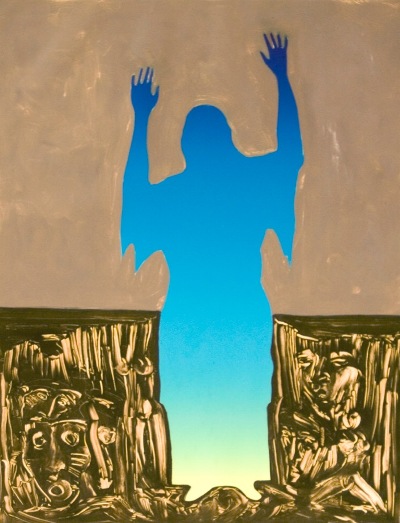
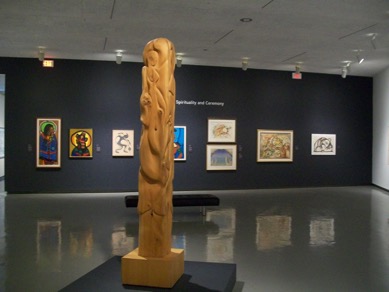

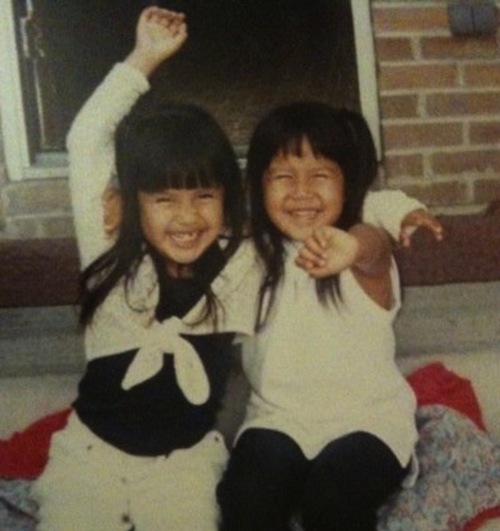
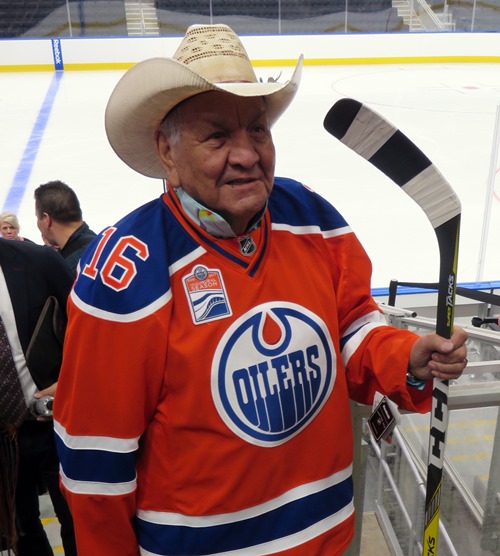
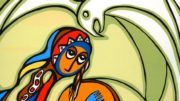
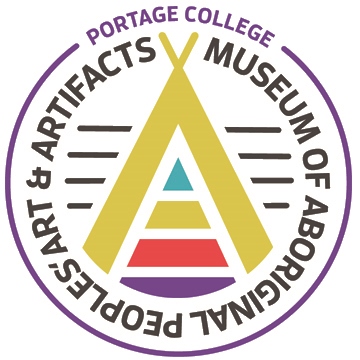
Your whole article is exactly why I founded Indian Uprising Art Gallery in 1991. AS a Native Artist, I quickly learned of the difficulties of getting my art in the Galleries. Even the most exclusive Art Show and sale in Montana, the Charley Russell in Great Falls doesn’t open doors for our N D N Artists. Considering how much Charley Russell loved our people, skins have a very difficult time getting past the application!!
One time a dear Artists friend of mine Harvey Rattey and I were showing at the Charley, and I yelled down to Harv, I’ll bet Charlie is rolling over in his grave Harv, cause we are the only two NDN’s here….
The artists who are selected can paint, draw,sculpt, bead Indians, but for the most part, they cannot be one!! Go figure!!